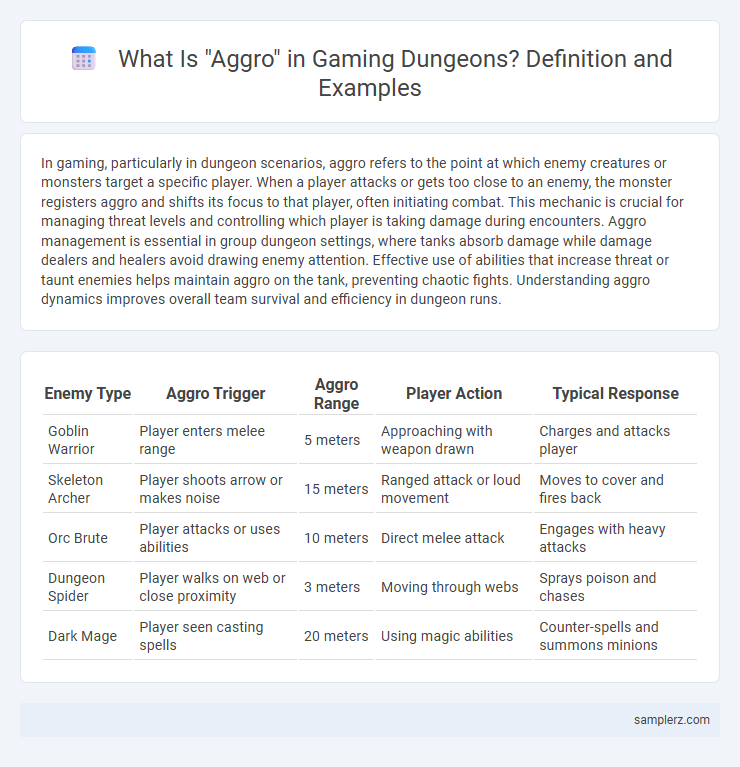In gaming, particularly in dungeon scenarios, aggro refers to the point at which enemy creatures or monsters target a specific player. When a player attacks or gets too close to an enemy, the monster registers aggro and shifts its focus to that player, often initiating combat. This mechanic is crucial for managing threat levels and controlling which player is taking damage during encounters. Aggro management is essential in group dungeon settings, where tanks absorb damage while damage dealers and healers avoid drawing enemy attention. Effective use of abilities that increase threat or taunt enemies helps maintain aggro on the tank, preventing chaotic fights. Understanding aggro dynamics improves overall team survival and efficiency in dungeon runs.
Table of Comparison
| Enemy Type | Aggro Trigger | Aggro Range | Player Action | Typical Response |
|---|---|---|---|---|
| Goblin Warrior | Player enters melee range | 5 meters | Approaching with weapon drawn | Charges and attacks player |
| Skeleton Archer | Player shoots arrow or makes noise | 15 meters | Ranged attack or loud movement | Moves to cover and fires back |
| Orc Brute | Player attacks or uses abilities | 10 meters | Direct melee attack | Engages with heavy attacks |
| Dungeon Spider | Player walks on web or close proximity | 3 meters | Moving through webs | Sprays poison and chases |
| Dark Mage | Player seen casting spells | 20 meters | Using magic abilities | Counter-spells and summons minions |
Understanding Aggro Mechanics in Dungeons
Aggro in dungeons refers to the way enemies target players based on threat levels generated by their actions, such as dealing damage or healing. Tanks typically maintain high aggro to keep enemies focused on them, protecting less durable party members like healers and damage dealers. Mastery of aggro mechanics ensures efficient dungeon runs by preventing enemy attacks from overwhelming vulnerable teammates.
Classic Aggro Example: The Tank Pulls First
In classic dungeon gameplay, aggro management begins when the tank pulls the first mob to establish threat priority. By using taunt abilities and high-threat attacks, the tank maintains enemy focus, preventing damage to vulnerable party members. Proper aggro control ensures smoother dungeon runs by minimizing unexpected mob aggression and enhancing team survivability.
Overhealing and Healer Aggro Scenarios
In dungeon scenarios, aggro often spikes when excessive overhealing generates unnecessary threat on healers, drawing enemy focus away from tanks. Overhealing occurs when healers restore more health than allies actually need, inflating threat meters and triggering boss or mob attacks on the healer instead of damage dealers or tanks. Managing overhealing in healer aggro scenarios is crucial for maintaining threat balance and ensuring successful dungeon pulls.
DPS Burst Damage Leading to Unexpected Aggro
DPS players dealing burst damage in dungeons can often generate unexpected aggro by rapidly overwhelming enemy threat thresholds, causing mobs to shift focus from tanks to high-damage dealers. This sudden threat spike disrupts tank control, forcing healers and tanks to react quickly to avoid party wipes. Understanding threat mechanics and pacing burst damage helps maintain aggro management and dungeon flow.
Line of Sight Tactics to Control Aggro
Aggro management in dungeon encounters relies heavily on Line of Sight (LoS) tactics to control enemy behavior effectively. By positioning characters behind pillars or around corners, players can break the enemy's LoS, causing mobs to lose target and reset their aggression. This strategic use of environmental obstacles helps tanks mitigate incoming damage while allowing DPS to optimize attack windows without drawing unwanted aggro.
Aggro Reset Phases During Dungeon Boss Fights
Aggro reset phases during dungeon boss fights occur when bosses temporarily drop all current targets to reposition or unleash area-of-effect abilities, forcing players to manage threat generation carefully. These resets can cause damage dealers and healers to regain aggro quickly if threat meters are not properly controlled, emphasizing the importance of precise tanking and cooldown management. Understanding boss behavior patterns in games like World of Warcraft or Final Fantasy XIV allows teams to synchronize DPS and healing to prevent unintended aggro spikes during these critical moments.
Crowd Control Failures and Aggro Consequences
Aggro mismanagement in dungeon raids often leads to crowd control failures, where tank players lose enemy focus, causing mobs to target fragile DPS or healers. This breakdown results in chaotic encounters, increased team damage, and potential wipes, as uncontrolled enemies disrupt strategic positioning and interrupt critical abilities. Effective crowd control and precise aggro management are crucial to maintaining raid stability and minimizing enemy aggression.
Miscommunication and Accidental Aggro Pulls
Accidental aggro pulls in dungeon runs often stem from miscommunication between team members, such as unclear tank positioning or unintended AoE spells triggering enemy attention. Players lacking coordination can inadvertently break stealth or initiate combat prematurely, causing the group to face overwhelming enemy numbers. Effective voice communication and pre-fight strategies significantly reduce these accidental threats and improve overall dungeon efficiency.
Pet Aggro Management in Dungeon Groups
Effective Pet Aggro Management in dungeon groups is crucial for maintaining control during intense fights, ensuring pets do not divert enemy focus away from the main tank. By utilizing threat-generating abilities and monitoring aggro levels closely, players can prevent pets from pulling additional mobs, which could overwhelm the group. Proper coordination between the pet owner and tank minimizes accidental aggro shifts, optimizing overall dungeon performance and survival.
Tips for Preventing Unwanted Aggro in Dungeons
Maintaining enemy aggro control in dungeons requires careful mitigation techniques such as utilizing crowd control spells, applying taunts strategically, and positioning party members to avoid unnecessary threat generation. Tanks should prioritize threat generation abilities and monitor threat meters closely while DPS players manage spell rotations to minimize overaggro. Communication among group members ensures coordinated pulls and reduces accidental enemy aggression, enhancing overall dungeon efficiency.

example of aggro in dungeon Infographic
 samplerz.com
samplerz.com